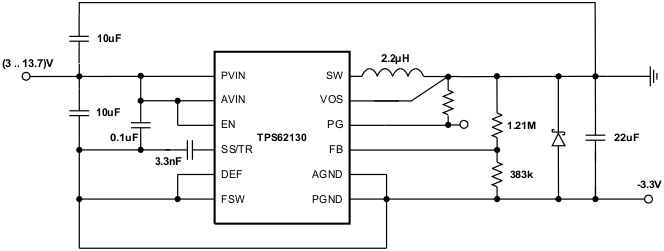SLVSAG7F November 2011 – November 2021 TPS62130 , TPS62130A , TPS62131 , TPS62132 , TPS62133
PRODUCTION DATA
- 1 Features
- 2 Applications
- 3 Description
- 4 Revision History
- 5 Device Comparison Table
- 6 Pin Configuration and Functions
- 7 Specifications
- 8 Detailed Description
- 9 Application and Implementation
- 10Power Supply Recommendations
- 11Layout
- 12Device and Documentation Support
- 13Mechanical, Packaging, and Orderable Information
9.3.3 –3.3-V Inverting Power Supply
The TPS62130 can be used as an inverting power supply by rearranging external circuitry as shown in Figure 9-42. As the former GND node now represents a voltage level below system ground, the voltage difference between VIN and VOUT has to be limited for operation to the maximum supply voltage of 17 V (see Equation 16).

 Figure 9-42 –3.3-V Inverting Power
Supply
Figure 9-42 –3.3-V Inverting Power
SupplyThe transfer function of the inverting power supply configuration differs from the buck mode transfer function, incorporating a right half plane zero additionally. The loop stability has to be adapted and an output capacitance of at least 22 µF is recommended. A detailed design example is given in Using the TPS6215x in an Inverting Buck-Boost Topology Application Report.